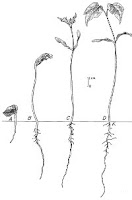In the second part of the series we looked at how we obtain the seeds for the work of planting a church. But the phrase 'planting a church' is loaded with meaning from our past experiences. We'd better define it before we begin to apply it here.
 We've already decided that a church is a place where brothers and sisters live in harmony in the presence of the King, Jesus. It's not about us gathering, it's about him being among us. He, not we, define church. If he's not at the centre then although it's a gathering, it's not church. So planting a church means setting in place a community where he is at the centre and his people gather around him. That gets the purpose and intention into clear focus.
We've already decided that a church is a place where brothers and sisters live in harmony in the presence of the King, Jesus. It's not about us gathering, it's about him being among us. He, not we, define church. If he's not at the centre then although it's a gathering, it's not church. So planting a church means setting in place a community where he is at the centre and his people gather around him. That gets the purpose and intention into clear focus.The seeds are welcoming, open people who are already primed with life but are currently dormant. They may have been dormant for a long time or just for a short while. If we can provide them with the right environment these people will grow - just try and stop them! So we need to look at the environment in which these people (seeds of church) are living.
What we must not do is uproot them from their environment and move them into our environment. That is often what happens but it's a serious mistake. If we move them they may wither in the new environment where they are surrounded by people they don't know. Much wiser to spend time with them amongst their own friends, family, or workmates and try to modify that environment in helpful, encouraging ways. Jesus said that when we are welcomed we should remain there (Luke 10:7). I don't think that necessarily means living in someone's house (though sometimes it will), but it certainly means living in that person's circle instead of drawing them into your own.
Read Luke 10:1-16 and Matthew 10:5-14 carefully and make a note of other things you should do or not do. There's a lot to consider in those verses. Pray about the things you find there and your attitude to those things.
A gardener would assess the situation and so should we. The gardener might notice the soil was too dry, or choked by weeds, or poorly drained, or much too shallow. He would prepare it according to its need by watering it, hoeing out the weeds, adding sand or compost, or building up the level.
We need to be observant, wise, and discerning. We might notice that the 'seed' person isn't reading the Bible, doesn't understand prayer very well, or perhaps hasn't heard or understood Christ's message of good news. We might therefore need to begin a Bible study with them, discuss and model prayer with them, or share the gospel (the good news).
If our discernment is good and what we do is appropriate we will soon begin to see them living more and more abundantly, growing in grace and love and excitement. These are just examples of the kind of thing that may help to prepare the ground. Pray fervently about the seed and your efforts at preparing the soil. Practice listening to the Holy Spirit - he will show you what to do and say. (You might like to use or adapt some of the priciples of CO2, you might consider doing this with the person you are helping, or you could do it with one of your believing friends.)
Look for natural opportunities as Philip did with the Ethiopian eunuch (Acts 4:26-40). Don't smother people with over-attention, give them breathing space to process what they have already absorbed.
Don't talk about doctrine or traditions or denominations. Focus as much as possible on revealing Christ to the person you are helping. There is so much in the New Testament - how he related to his followers and talked with them, the care and love he showed to those in need, his words on the hillside, Paul's abundant writings about love and other good things. You and the one you are helping will benefit by studying Jesus and spending time with him more than in any other way.
When the conditions are right and as time passes you will find signs of growth and it's likely the person will want to involve other friends or family. Encourage this - the seed is developing a root and a shoot and is already becoming a baby church without prompting from you! HalleluYah!
Next time we'll look at the details of planting the seed.
< Obtain seeds | Index | Plant the seeds >



